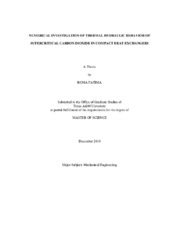| dc.contributor.advisor | Ranjan, Devesh | |
| dc.creator | Fatima, Roma | |
| dc.date.accessioned | 2012-02-14T22:18:43Z | |
| dc.date.accessioned | 2012-02-16T16:13:26Z | |
| dc.date.available | 2012-02-14T22:18:43Z | |
| dc.date.available | 2012-02-16T16:13:26Z | |
| dc.date.created | 2010-12 | |
| dc.date.issued | 2012-02-14 | |
| dc.date.submitted | December 2010 | |
| dc.identifier.uri | https://hdl.handle.net/1969.1/ETD-TAMU-2010-12-8872 | |
| dc.description.abstract | The present work seeks to investigate the thermal hydraulic (heat transfer and fluid dynamics) behavior of supercritical (Sc) fluids at both the fundamental and applied levels. The thermal hydraulics of these fluids is not very well known although they have been used in various applications. There are drastic changes in the thermal and hydraulic properties of fluids at supercritical conditions. There has been a lot of focus to effectively utilize these properties changes in many applications such as heat exchangers.
This work focuses on studying the forced convective heat transfer of Sc-CO2 in a series of mini semi-circular horizontal tubes and a zig-zag shaped horizontal channel. The problems were investigated numerically by second-order finite volume method using a commercial software FLUENT. Three dimensional Computational Fluid Dynamics (CFD) models were developed to simulate the flow and heat transfer for three different geometries – a single semi-circular channel, a series of nine parallel semi-circular channels and a zig-zag channel. Grid and accuracy refinement studies were carried out to assess numerical errors. All the computational meshes developed for this study incorporated the first node cell within the viscous sub-layer i.e. y <1. Since the flow is turbulent, an appropriate choice of turbulence model is highly desirable. Henceforth, various turbulence models were used to study their impact on the heat transfer solution for these problems.
The present numerical work focuses on improving the CFD model and methodologies in order to capture the experimental data of the heat transfer spike at the super critical conditions. Local and average heat transfer coefficients near the critical point were determined from measured wall temperatures and calculated local bulk temperatures. The numerical results are compared with the experiments. The numerical predictions do not convincingly agree with the experiments. This could be because of the incapability of turbulent models to capture the flow physics accurately due to the rapid changes in the fluid properties near critical conditions. | en |
| dc.format.mimetype | application/pdf | |
| dc.language.iso | en_US | |
| dc.subject | CFD | en |
| dc.subject | FLUENT | en |
| dc.subject | Supercritical | en |
| dc.subject | numerical | en |
| dc.subject | bulk temperatures | en |
| dc.subject | semi-circular channel | en |
| dc.subject | heat transfer | en |
| dc.subject | heat transfer coefficient | en |
| dc.title | Numerical Investigation of Thermal Hydraulic Behavior of Supercritical Carbon Dioxide in Compact Heat Exchangers | en |
| dc.type | Thesis | en |
| thesis.degree.department | Mechanical Engineering | en |
| thesis.degree.discipline | Mechanical Engineering | en |
| thesis.degree.grantor | Texas A&M University | en |
| thesis.degree.name | Master of Science | en |
| thesis.degree.level | Masters | en |
| dc.contributor.committeeMember | Nakshatrala, Kalyana | |
| dc.contributor.committeeMember | Yassin, Hassan | |
| dc.type.genre | thesis | en |
| dc.type.material | text | en |


